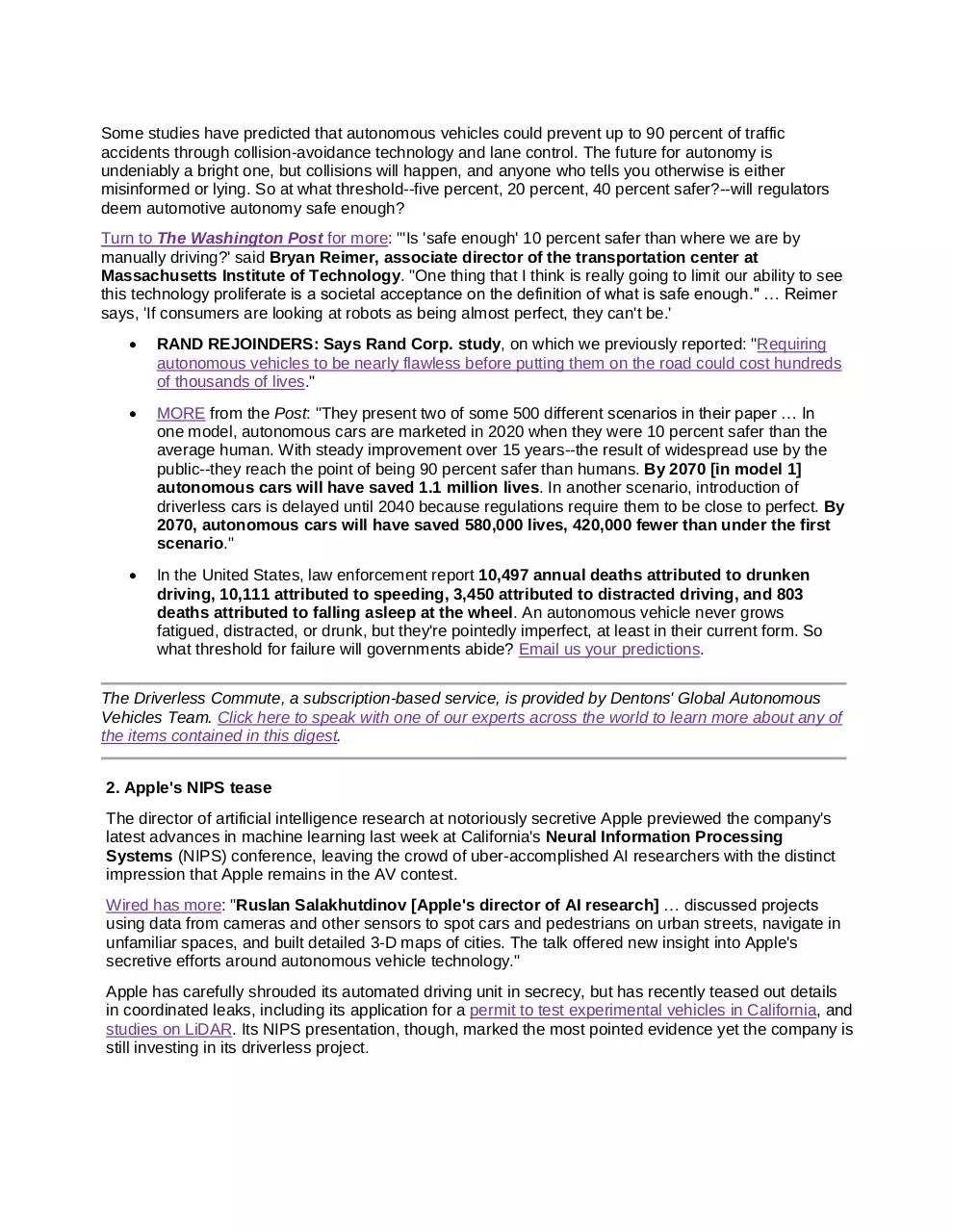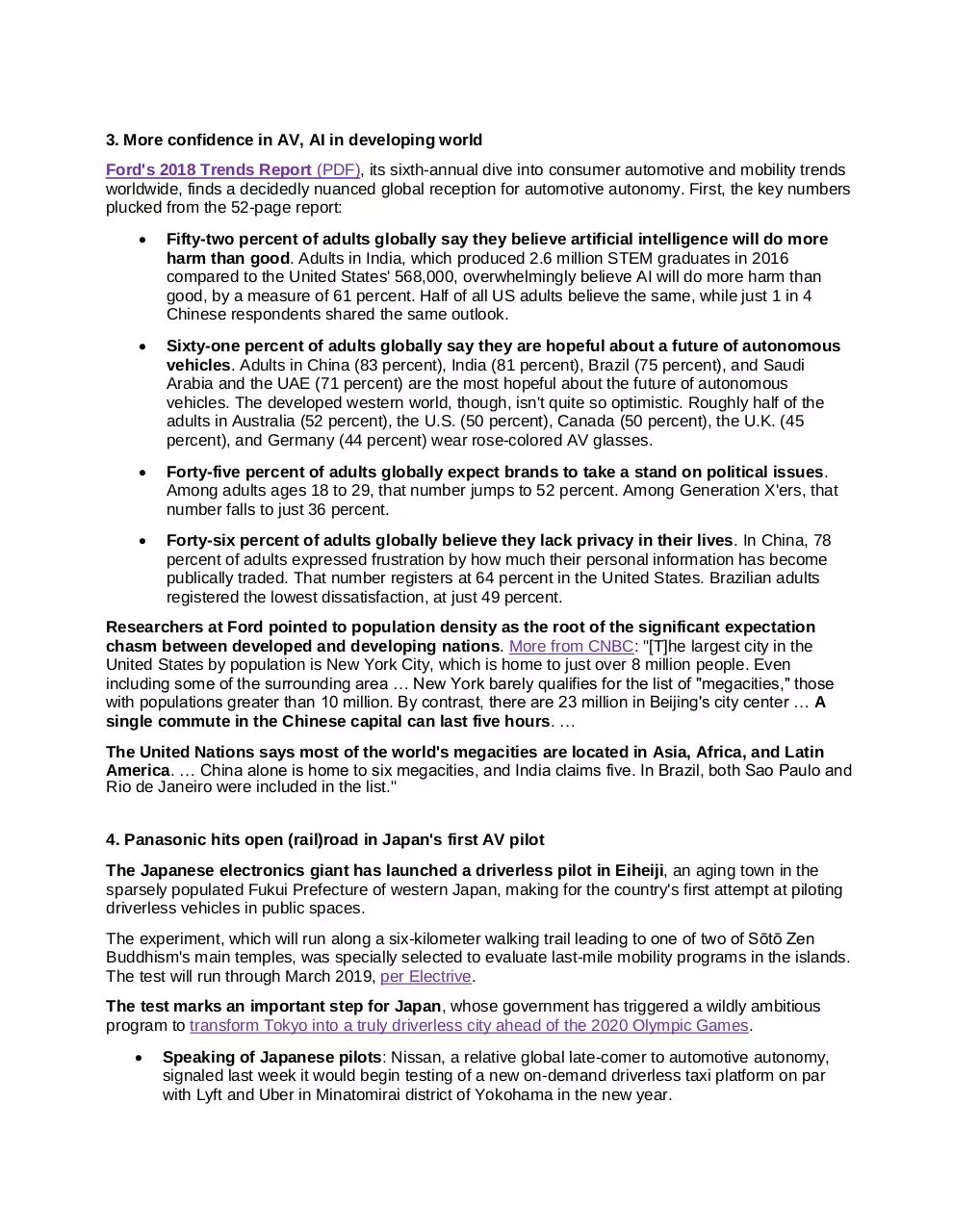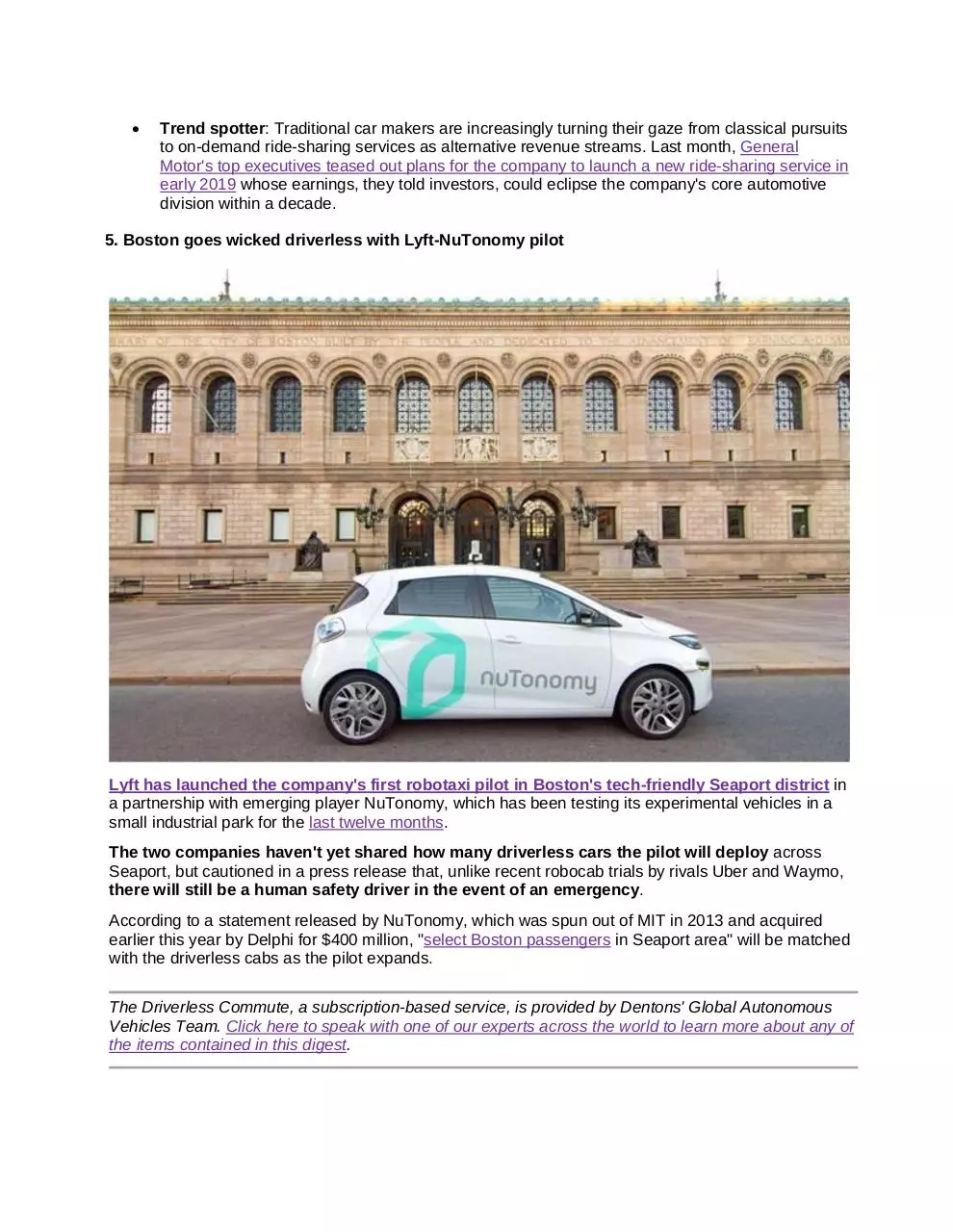DC 121117 (PDF)
File information
This PDF 1.4 document has been generated by Aspose Ltd. / Aspose.Pdf for .NET 9.7.0, and has been sent on pdf-archive.com on 12/12/2017 at 16:08, from IP address 104.37.x.x.
The current document download page has been viewed 534 times.
File size: 453.35 KB (6 pages).
Privacy: public file





File preview
From:
Sent:
To:
Subject:
Eric Tanenblatt and James Richardson
Tuesday, December 12, 2017 9:46 AM
Eric Tanenblatt and James Richardson
Driverless Commute, presented by Dentons: Lyft's first robocab pilot;
developing nations enthusiast for AV rollout; Apple reminds us they're still
around; and Japan set to pursue two new AV pilots in new year
Welcome again to the Driverless Commute, presented by Dentons, a weekly drive time digest
clocking the most important technical, legal, and regulatory developments shaping the path to global
autonomy.
If you believe a colleague or associate would benefit from this service, please email us so they may
receive future editions.
By James Richardson and Eric Tanenblatt
1. The trillion dollar question: How safe is "safe enough?"
In our inaugural edition, your Driverless Commute correspondents wondered, in qualitative terms, what
constitutes a sufficiently safe autonomous vehicle. It's a complex question of machine morality and
ethical rule-making to which we--and governments across the world--still lack a clear answer.
In the United States, transportation authorities report that 94 percent of all car crashes are the
consequence of human error. Worldwide, that translates to some 1.25 million deaths annually. For
relative scale, that's equivalent to seven wide-body airliners crashing. Every day.
Some studies have predicted that autonomous vehicles could prevent up to 90 percent of traffic
accidents through collision-avoidance technology and lane control. The future for autonomy is
undeniably a bright one, but collisions will happen, and anyone who tells you otherwise is either
misinformed or lying. So at what threshold--five percent, 20 percent, 40 percent safer?--will regulators
deem automotive autonomy safe enough?
Turn to The Washington Post for more: "'Is 'safe enough' 10 percent safer than where we are by
manually driving?' said Bryan Reimer, associate director of the transportation center at
Massachusetts Institute of Technology. "One thing that I think is really going to limit our ability to see
this technology proliferate is a societal acceptance on the definition of what is safe enough." … Reimer
says, 'If consumers are looking at robots as being almost perfect, they can't be.'
RAND REJOINDERS: Says Rand Corp. study, on which we previously reported: "Requiring
autonomous vehicles to be nearly flawless before putting them on the road could cost hundreds
of thousands of lives."
MORE from the Post: "They present two of some 500 different scenarios in their paper … In
one model, autonomous cars are marketed in 2020 when they were 10 percent safer than the
average human. With steady improvement over 15 years--the result of widespread use by the
public--they reach the point of being 90 percent safer than humans. By 2070 [in model 1]
autonomous cars will have saved 1.1 million lives. In another scenario, introduction of
driverless cars is delayed until 2040 because regulations require them to be close to perfect. By
2070, autonomous cars will have saved 580,000 lives, 420,000 fewer than under the first
scenario."
In the United States, law enforcement report 10,497 annual deaths attributed to drunken
driving, 10,111 attributed to speeding, 3,450 attributed to distracted driving, and 803
deaths attributed to falling asleep at the wheel. An autonomous vehicle never grows
fatigued, distracted, or drunk, but they're pointedly imperfect, at least in their current form. So
what threshold for failure will governments abide? Email us your predictions.
The Driverless Commute, a subscription-based service, is provided by Dentons' Global Autonomous
Vehicles Team. Click here to speak with one of our experts across the world to learn more about any of
the items contained in this digest.
2. Apple's NIPS tease
The director of artificial intelligence research at notoriously secretive Apple previewed the company's
latest advances in machine learning last week at California's Neural Information Processing
Systems (NIPS) conference, leaving the crowd of uber-accomplished AI researchers with the distinct
impression that Apple remains in the AV contest.
Wired has more: "Ruslan Salakhutdinov [Apple's director of AI research] … discussed projects
using data from cameras and other sensors to spot cars and pedestrians on urban streets, navigate in
unfamiliar spaces, and built detailed 3-D maps of cities. The talk offered new insight into Apple's
secretive efforts around autonomous vehicle technology."
Apple has carefully shrouded its automated driving unit in secrecy, but has recently teased out details
in coordinated leaks, including its application for a permit to test experimental vehicles in California, and
studies on LiDAR. Its NIPS presentation, though, marked the most pointed evidence yet the company is
still investing in its driverless project.
3. More confidence in AV, AI in developing world
Ford's 2018 Trends Report (PDF), its sixth-annual dive into consumer automotive and mobility trends
worldwide, finds a decidedly nuanced global reception for automotive autonomy. First, the key numbers
plucked from the 52-page report:
Fifty-two percent of adults globally say they believe artificial intelligence will do more
harm than good. Adults in India, which produced 2.6 million STEM graduates in 2016
compared to the United States' 568,000, overwhelmingly believe AI will do more harm than
good, by a measure of 61 percent. Half of all US adults believe the same, while just 1 in 4
Chinese respondents shared the same outlook.
Sixty-one percent of adults globally say they are hopeful about a future of autonomous
vehicles. Adults in China (83 percent), India (81 percent), Brazil (75 percent), and Saudi
Arabia and the UAE (71 percent) are the most hopeful about the future of autonomous
vehicles. The developed western world, though, isn't quite so optimistic. Roughly half of the
adults in Australia (52 percent), the U.S. (50 percent), Canada (50 percent), the U.K. (45
percent), and Germany (44 percent) wear rose-colored AV glasses.
Forty-five percent of adults globally expect brands to take a stand on political issues.
Among adults ages 18 to 29, that number jumps to 52 percent. Among Generation X'ers, that
number falls to just 36 percent.
Forty-six percent of adults globally believe they lack privacy in their lives. In China, 78
percent of adults expressed frustration by how much their personal information has become
publically traded. That number registers at 64 percent in the United States. Brazilian adults
registered the lowest dissatisfaction, at just 49 percent.
Researchers at Ford pointed to population density as the root of the significant expectation
chasm between developed and developing nations. More from CNBC: "[T]he largest city in the
United States by population is New York City, which is home to just over 8 million people. Even
including some of the surrounding area … New York barely qualifies for the list of "megacities," those
with populations greater than 10 million. By contrast, there are 23 million in Beijing's city center … A
single commute in the Chinese capital can last five hours. …
The United Nations says most of the world's megacities are located in Asia, Africa, and Latin
America. … China alone is home to six megacities, and India claims five. In Brazil, both Sao Paulo and
Rio de Janeiro were included in the list."
4. Panasonic hits open (rail)road in Japan's first AV pilot
The Japanese electronics giant has launched a driverless pilot in Eiheiji, an aging town in the
sparsely populated Fukui Prefecture of western Japan, making for the country's first attempt at piloting
driverless vehicles in public spaces.
The experiment, which will run along a six-kilometer walking trail leading to one of two of Sōtō Zen
Buddhism's main temples, was specially selected to evaluate last-mile mobility programs in the islands.
The test will run through March 2019, per Electrive.
The test marks an important step for Japan, whose government has triggered a wildly ambitious
program to transform Tokyo into a truly driverless city ahead of the 2020 Olympic Games.
Speaking of Japanese pilots: Nissan, a relative global late-comer to automotive autonomy,
signaled last week it would begin testing of a new on-demand driverless taxi platform on par
with Lyft and Uber in Minatomirai district of Yokohama in the new year.
Trend spotter: Traditional car makers are increasingly turning their gaze from classical pursuits
to on-demand ride-sharing services as alternative revenue streams. Last month, General
Motor's top executives teased out plans for the company to launch a new ride-sharing service in
early 2019 whose earnings, they told investors, could eclipse the company's core automotive
division within a decade.
5. Boston goes wicked driverless with Lyft-NuTonomy pilot
Lyft has launched the company's first robotaxi pilot in Boston's tech-friendly Seaport district in
a partnership with emerging player NuTonomy, which has been testing its experimental vehicles in a
small industrial park for the last twelve months.
The two companies haven't yet shared how many driverless cars the pilot will deploy across
Seaport, but cautioned in a press release that, unlike recent robocab trials by rivals Uber and Waymo,
there will still be a human safety driver in the event of an emergency.
According to a statement released by NuTonomy, which was spun out of MIT in 2013 and acquired
earlier this year by Delphi for $400 million, "select Boston passengers in Seaport area" will be matched
with the driverless cabs as the pilot expands.
The Driverless Commute, a subscription-based service, is provided by Dentons' Global Autonomous
Vehicles Team. Click here to speak with one of our experts across the world to learn more about any of
the items contained in this digest.
Download DC 121117
DC_121117.pdf (PDF, 453.35 KB)
Download PDF
Share this file on social networks
Link to this page
Permanent link
Use the permanent link to the download page to share your document on Facebook, Twitter, LinkedIn, or directly with a contact by e-Mail, Messenger, Whatsapp, Line..
Short link
Use the short link to share your document on Twitter or by text message (SMS)
HTML Code
Copy the following HTML code to share your document on a Website or Blog
QR Code to this page

This file has been shared publicly by a user of PDF Archive.
Document ID: 0000707654.